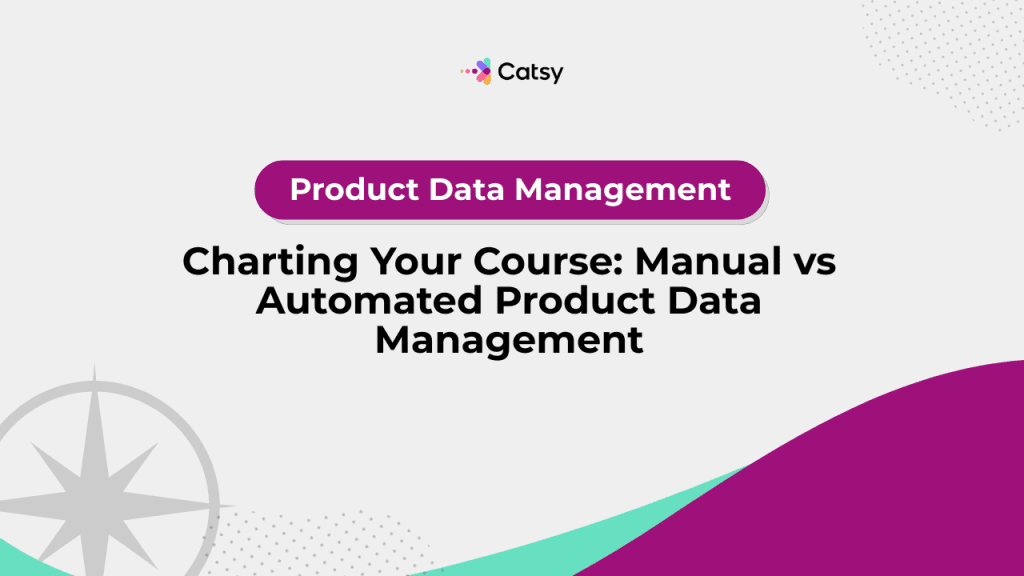Charting Your Course: Manual vs Automated Product Data Management
Is an automated approach to data management right for you? Perform a cost-benefit analysis using these pointers to decide whether it’s time to transition.

Navigation Overview
What You’ll Learn:
- The true costs of manual vs automated product data management
- ROI calculations for different business scales
- Key factors for choosing the right approach
- Implementation strategies that chart a course for success
In this Article
Product Data Management: Setting Your Bearings
Today’s marketplace is competitive, and your product data is the compass to success. Product data management, then, is critical; it encompasses the collection, maintenance, and distribution of everything your customers see. From basic descriptions to volume-level pricing, your data matters.
What is Product Data Management?
Product data management refers to the systematic approach to handling all product-related information. Even if you sell across multiple channels, product data management delivers accuracy, consistency, and accessibility.
The choice between manual and automated product data management is a strategic business choice – it impacts your operations at their heart. As you expand and your catalogs grow, manual data entry becomes less and less of a feasible option; automation becomes necessary.
Why Your Data Strategy Matters More Than Ever
Over a short period of time, the digital commerce landscape has evolved dramatically. Consumers now expect accurate and up-to-date information across each and every touchpoint. Just one data error can result in lost sales, returns, and damaged trust.
When you implement effective product data management, you’re investing in the foundation of your customers’ experiences. And the scale and complexity of modern e-commerce operations often determine which approach delivers the best return on investment.
Manual processes may be just fine for smaller operations with infrequent updates. But if you plan to scale your business, it’s time to take a look at automation. Understanding the cost-benefit equation associated with manual versus automated product updates is critical as you evaluate your data management options.
Make Catsy DAM and PIM Software an Extension of Your Team
Book a Free DemoManual Product Data Management: Calculating the True Costs
Direct Labor Costs:
Manual data entry time varies significantly based on your product complexity and your unique business. If you have a substantial catalog that requires regular manual updates, it can translate to huge monthly labor investments… This investment scales directly alongside your catalog size.
Hidden Costs of Manual Processes:
- Error rates: Manual data entry carries higher error rates compared to automated systems, leading to customer complaints, returns, and lost sales
- Inconsistency: Different team members may format information differently, creating brand confusion
- Scalability limitations: Adding new products or channels requires a proportional increase in manual labor
- Opportunity costs: Staff time spent on data entry could be allocated to higher-value activities like relationship building or marketing
Quality Control Overhead: Manual processes require additional review cycles, and this can often double the time investment. A single pricing error across multiple channels can cost thousands of dollars in lost revenue.
Automated Product Data Management: Charting Efficient Waters
Initial Investment Considerations:
An automated system can require a fairly hefty initial investment. Costs will vary based on the complexity and integration requirements of your business. However, the investment often provides considerable returns through efficiency gains and reduction of errors.
Ongoing Operational Benefits:
- Speed: Automated systems can process thousands of products in minutes, not hours
- Accuracy: Error rates drop significantly with proper system configuration
- Consistency: Standardized formatting and data validation ensure uniform presentation
- Scalability: Adding new products or channels requires minimal additional effort
Long-term ROI Advantages: Businesses typically see substantial returns on investment within the first few years of implementing automated product data management.
Top 5 Factors to Consider When Setting Your Course
- Catalog Size and Growth Rate: A smaller catalog may not need to be updated as frequently as a large one, and manual processes may be cost effective. However, in order to scale, most businesses experience success with automated systems. These systems provide better long-term value through improved efficiency.
- Channel Complexity: Selling across multiple platforms like Amazon and eBay increases your manual workload significantly. Automated systems are a great solution for multi-channel distribution and synchronization.
- Data Update Frequency: Products that require daily price updates, inventory synchronization, or seasonal modifications will quickly overwhelm your manual processes. Automation becomes essential for maintaining accurate, real-time data.
- Available Resources: Consider both your personnel and your financial resources as you decide whether to automate. Sometimes phased automation approaches offer the best balance.
- Industry Requirements: Highly regulated industries benefit significantly from automated validation and compliance features. This is true for those requiring complex product specifications like the automotive, electronics, and healthcare industries.
Real-World Examples of Successful Navigation
Case Study: Mid-Size Retailer Transformation
A home goods retailer with a large product catalog was dedicating significant weekly hours to manual data management.
By implementing automated systems, the company dramatically reduced the time they spent on data management while improving their accuracy! The investment was quickly recovered through savings in labor and improved efficiency.
E-commerce Marketplace Success Story
An electronics distributor managed a large SKU count across multiple platforms. Data-related customer complaints were significantly reduced after implementation of automation.
Customer satisfaction scores increased notably, directly correlating with improved data accuracy and consistency.
These examples demonstrate that while successful automation makes life easier across your teams, it also earns your business money in ways that manual processes can’t match.
Working with Data Management Navigators
To implement an effective product data strategy you need specialized expertise. Whether you’re optimizing your manual processes or transitioning to automation, the complexity of modern e-commerce systems often exceeds a business’s internal capabilities.
Professional data management consultants provide this expertise through their experience in system selection, implementation planning, and even change management. Your consultant will understand the unique needs of your industry, and can help you chart the optimal automation level you need.
As you’re evaluating potential partners, look for specialists with proven track records in your industry and comprehensive understanding of both manual and automated approaches. The ideal partner should be available for future scaling, too.
Key Takeaways
- Manual processes work for small catalogs but become increasingly expensive and inefficient as a business scales
- Automated systems typically deliver substantial return on investment within the first few years, even for businesses with larger product catalogs
- The optimal approach depends on catalog size, update frequency, and channel complexity… there are few, if any, one-size-fits-all solutions
- The hidden costs of manual processes (these may include errors, inconsistency, and opportunity costs) often exceed direct labor costs
- Successful automation requires proper planning, system selection, and often professional implementation support
Want more tips, tutorials, and insights on product content and e-commerce operations?
Stay connected. We post regularly to help brands like yours scale smarter.
Are You Ready To streamline your product content management?

Frequently Asked Questions
Most businesses with over 500 SKUs or those updating data more than weekly see positive returns from automation, typically within 12 to 18 months.
That said, if your company has complex multi-channel operations it may benefit from automation – even if your catalog is smaller. The key factors to consider are update frequency, channel complexity, and error tolerance – not just the size of your catalog.
Yep! A hybrid approach will often provide excellent ROI. Your high-volume, routine tasks are automated while you maintain manual control over complex elements of your data.
Common starting points may include automated price updates, inventory synchronization, and basic data validation. Your teams may choose to keep control of manually written content like product descriptions.
In your calculations, include direct labor costs, such as:
- Data entry
- Manual updates
- Quality control
- Consumer queries
- Returns
- Lost sales
You’ll also want to consider opportunity costs… What else could staff accomplish? Finally, scalability limitations should be factored in. Many businesses underestimate these hidden costs by 50 to 70 percent.
There are a few primary risks associated with making the transition. Data migration errors, system integration challenges, staff resistance, and choosing the appropriate level of automation are a few. Proper planning is essential, and working with experienced partners as you implement will be a game changer.
Subscribe For More Content
Sign up for monthly tips on how to drive revenue with product content.




